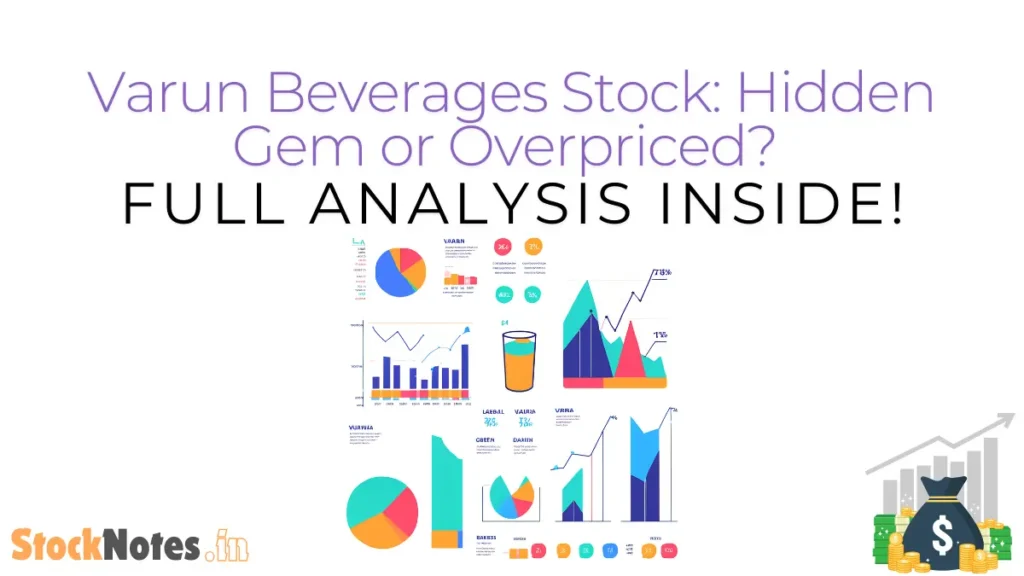Varun Beverages Stock: Hidden Gem or Overpriced? Full Analysis Inside!
- stocknotes.in
- March 29, 2025
If you’ve ever grabbed a bottle of Pepsi, Mountain Dew, or Tropicana in India, high chances are it came from Varun Beverages Ltd. (VBL)—one of PepsiCo’s largest bottlers and distributors in the world. But is this stock as refreshing as its drinks? Let’s analyze it based on key financials, growth metrics, and valuation to see if it’s worth adding to your portfolio.
So here we are seeing the varun beverages from the long term view minimum 1-2 years also it is the blue-chip stock so you can hold it for the long term like 5 years.

Understanding the Business
Varun Beverages operates under a franchise agreement with PepsiCo, meaning it has exclusive rights to manufacture, bottle, distribute, and sell PepsiCo’s beverages like Pepsi, Mirinda, 7UP, Mountain Dew, and Tropicana in certain territories. This allows it to focus on operations while leveraging PepsiCo’s strong brand presence. Making it a dominant player in the soft drink industry.
Now, let’s see how strong it in the numbers and ratios
Key Financial Metrics
Metric | Value | My Analysis |
Market Cap | ₹ 1,64,996 Cr | Large-cap stock, indicating stability. |
Current Price | ₹ 540 | Decent price, but let’s check valuation. |
52-Week High/Low | ₹ 683 / 419 | Near lower range, could be a buy signal. |
Stock P/E | 63.6 | High P/E means expensive stock, but growth justifies it. |
Price to Book (P/B) | 9.93 | Expensive compared to book value. |
Sales Growth (YoY) | 24.7% | Strong revenue growth! |
3-Year Sales Growth | 31.4% | Consistently strong growth. |
Profit Growth (YoY) | 22.4% | Impressive earnings increase. |
3-Year Profit Growth | 54.3% | Long-term profitability is strong. |
Return on Equity (ROE) | 22.0% | Excellent return on shareholders’ money. |
3-Year ROE | 27.9% | Sustained high profitability. |
Return on Capital Employed (ROCE) | 24.2% | Great efficiency in using capital. |
3-Year ROCE | 26.8% | Consistent returns, indicating good management. |
Debt-to-Equity (D/E) | 0.17 | Low debt, financially strong. |
PEG Ratio | 1.56 | Slightly expensive but justified for high growth. |
Dividend Yield | 0.20% | Very low; not a great dividend stock. |
Dividend Payout | 6.52% | Low payouts, reinvesting in growth. |
Operating Margin (OPM) | 23.5% | Strong margins, a sign of pricing power. |
Pledged Shares | 0.04% | Almost no pledged shares, safe bet. |
RSI (Relative Strength Index) | 46.9 | Neither overbought nor oversold. |
Growth Potential & Strengths
Dominant Market Position: Being the largest PepsiCo bottler in India gives Varun Beverages a monopoly-like advantage. Its exclusive agreement gives it an edge.
Consistent Growth: The company has delivered 30%+ CAGR growth in sales over three years—phenomenal!
Strong Profitability: High ROE and ROCE indicate efficient management and strong earnings growth.
Low Debt: A 0.17 debt-to-equity ratio means VBL isn’t burdened by loans, a big positive.
Consumption Growth Play: With rising disposable incomes and urbanization, soft drink consumption in India is set to grow, benefiting VBL.
Risks & Concerns
High Valuation: With a P/E of 63.6, the stock isn’t cheap. You’re paying a premium for its high growth. But usually high PE seen in the sector around 30-45.
Seasonal Business: Sales peak in summer, meaning earnings fluctuate.
Low Dividend Yield: If you’re looking for a dividend stock, this isn’t it. VBL reinvests most of its profits for expansion.
Competition & Regulations: The soft drink industry faces health concerns, sugar taxes, and increasing competition from local beverage brands.
Should You Invest?
Buy If:
You believe in India’s growing soft drink market.
You want a high-growth stock for the long term.
You’re okay with premium valuation for a market leader.
Avoid If:
You prefer undervalued stocks.
You want high dividend income.
You are uncomfortable with seasonal fluctuations.
For high dividend stock you can check Top 10 High Paying Dividend Stocks to Watch In 2025
My Verdict
Varun Beverages is a fundamentally strong, high-growth stock with a dominant market position. However, the current valuation is on the higher side, and investors should look for a dip before entering. For long-term investors, this could be a great portfolio addition, but expect short-term volatility.
Would I buy? Yes, but only on dips!
